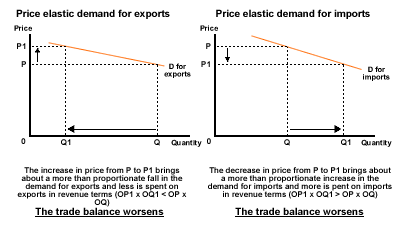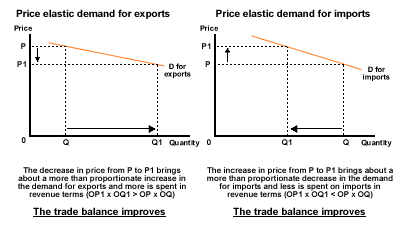Elasticity of demand for imports and exports
Syllabus: Examine the effects of changes in the terms of trade on a country’s current account, using the concepts of price elasticity of demand for exports and imports.A favourable movement in the terms of trade may have an unfavourable effect on the trade balance, while an unfavourable movement in the terms of trade may have a favourable affect the trade balance. |
This is because the terms of trade records relative price movements of exports and imports, while the current account of the balance of payments is concerned with export and import values (price x quantity bought / sold).
The impact of a change in the terms of trade on the trade balance will largely depend on the relative price elasticity of demand for exports and imports.
An improvement (favourable movement) in the terms of trade may worsen the trade balance - this will occur when the demand for exports and imports is price elastic.
An improvement in the terms of trade means that the price of exports increases relative to the price of imports.

Impact of an increase in terms of trade on balance of payments
A deterioration (unfavourable movement) in the terms of trade may improve the trade balance. This will occur when the demand for exports and imports is price elastic.
A worsening of the terms of trade means that the price of imports increases relative to the price of exports.

Impact of a decrease in terms of trade on balance of payments
The overall impact on the balance of payments current account of a change in the terms of trade depends on the combined price elasticities of demand for imports and exports. So:
- An improvement in the terms of trade will worsen the balance of payments current account if the demand for exports and imports is price elastic, and improve it if demand for exports and imports is price inelastic.
- A deterioration in the terms of trade will worsen the balance of payments current account if the demand for exports and imports is price inelastic and improve it if demand is price elastic.
Given that the developing countries' demand for exports and imports is relatively price inelastic, they have faced ever worsening balance of payments situations in response to their deteriorating terms of trade.
